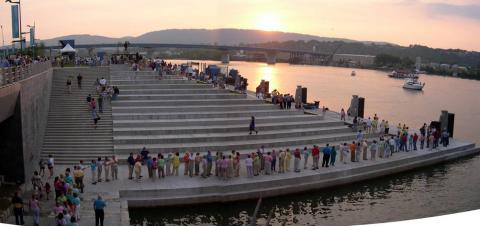Stuart Weitzman School of Design
102 Meyerson Hall
210 South 34th Street
Philadelphia, PA 19104
Get the latest Weitzman news in your Inbox
“Quite simply, the central waterfront has suffered for decades from an absence of planning and an absence of management. Regardless of what is decided about casinos, we need to commit to a course of thoughtful planning, capable implementation and well-funded management.”
-- Paul R. Levy, president, Center City District, Testimony before the City Council Rules Committee, February 25, 2008
Great visions require managers with the power and resources to implement them. We have set high standards for the future of the central Delaware, and we must set similarly high standards for the waterfront manager—the management organization that will have the responsibility of implementing the civic vision and the master plan to achieve waterfront revitalization over the long term. A waterfront redevelopment project succeeds or fails based upon the abilities of its manager and the strong, visionary leadership of the mayor and the City Council.

These are among the key functions the waterfront manager plays in peer cities:
- Implements waterfront master plan/civic vision over short and long term.
- Uses legal authority to acquire, hold and dispose of land and legal rights-of-way.
- Finances riverfront public-infrastructure projects through bond issues and other means.
- Coordinates efforts among government agencies and nonprofits to maximize effectiveness.
- Maintains an ongoing relationship between board and existing neighborhood organizations and keeps the public engaged in decision-making.
- Improves and maintains trails, greenways, parks and public spaces.
- Reviews proposed development in a manner that complements existing project review processes.
- Markets and promotes the waterfront as a destination and programs activities for the waterfront.
The waterfront manager’s mission should be to implement the Civic Vision for the Central Delaware and the anticipated master plan for the central Delaware in order to grow the city’s economy, improve quality of life along the river and in adjacent neighborhoods and ensure that each new development or open space adds to the attractiveness and health of the river’s edge. To be successful at this difficult job, the waterfront manager must have the means to finance capital improvements, acquire land and conservation easements, carry out operations and maintenance and improve open spaces. The waterfront manager must have adequate financial strength to be able to move the central Delaware project forward in times of economic downturn as well as real-estate booms—pushing forward parks, trails and street extensions even when economic conditions make private investors reluctant to move forward on large-scale, private development projects.

East Boston's Piers Park, which reclaims an old pier and provides direct waterfront access, is owned and maintained by the Massachusetts Port Authority.
After analyzing the four potential waterfront management structures (see sidebar), this action plan proposes that a reformed and rehabilitated Penn’s Landing Corporation is the best choice for waterfront manager. A reformed Penn’s Landing Corporation will have the powers and annual revenue needed to rapidly and effectively transform the riverfront. Penn’s Landing Corporation has the power to finance riverfront public-infrastructure projects through bond issues and other means, to buy and sell land and legal rights-of-way (although not to hold conservation easements) and to coordinate efforts among government agencies. The Penn’s Landing Corporation was established as a quasi-governmental corporation in 1970 to manage publicly owned land on the central Delaware; it now extends from just south of Washington Avenue to just north of Spring Garden Street (4). Philadelphia, like New York and other cities, believed that a powerful, quasi-governmental entity with the authority to issue bonds without voter approval, execute contracts without a lengthy bidding process and conduct business in private would bring new investment to a post-industrial riverfront efficiently. These corporations created for the public benefit, such as Penn’s Landing Corporation and Battery Park City Authority in New York City, were given many of the powers of government without the safeguards. As a result, they made decisions affecting the future of the city without public input, and they often became known as shadow governments susceptible to patronage and corruption (5).
A twenty-first century waterfront manager should have a clear mission statement and dedicated funding, be open, transparent, responsive to residents and property owners and accountable to the mayor and the public.
Penn’s Landing Corporation, as it is currently governed, could not be an effective waterfront manager. The 501(c)(4) corporation is neither open nor accountable. It has unpublished by-laws, holds all meetings behind closed doors and does not have a strategic plan that defines its policies or goals for the public. The Penn’s Landing Corporation does not operate under the Sunshine Act (the state law regulating open meetings) or any open records laws. While some publicly owned parcels have been successfully redeveloped, in its thirty-eight-year tenure, this agency has faced dramatic and very public failures in redeveloping the waterfront and has left publicly owned land underutilized. Discussions during the planning process for the Civic Vision for the Central Delaware revealed that Penn’s Landing Corporation has lost the trust of the majority of the four thousand Philadelphians who contributed to the civic vision. They view Penn’s Landing Corporation as a secretive agency that is a part of Philadelphia’s backroom political culture. The model of a quasi-governmental organization with no accountability to voters has not worked.
Penn’s Landing Corporation can be rehabilitated into an effective, open and accountable waterfront manager through a reform processthat is very public and that results in a very different type of agency. A complete rehabilitation of its governance and budget processes will be needed to transform this agency into a twenty-first century waterfront manager and to reclaim the public’s trust. Its articles of incorporation can be amended to increase its geographic jurisdiction to include the whole central Delaware area. Its board can be changed to reduce the number of political appointments, creating a leaner corporate structure. Regional corporate leaders will serve on the board as well as residents and experts in areas such as law, architecture, planning, fundraising and development (9). A requirement currently included in deed agreements with the Philadelphia Redevelopment Authority that all public land be leased or sold for fair market value or higher should also be changed because it precludes the use of public land for parks and public spaces (10).
Penn’s Landing Corporation has a board made up of twenty-six members, each serving a three-year staggered term. The mayor is a board member, along with seven other members of his administration. Other public board-member positions include the president of City Council and First District councilperson, First District state senator and First District Congressperson, representatives of three local Chambers of Commerce and the chairpersons of the Redevelopment Authority and Philadelphia Industrial Development Corporation. In addition, nine private-sector members are elected by the board, typically after being recommended by the mayor. Each year, three of these private-sector members are selected. In FY 2007, the corporation’s revenues were $8,462,275. Significantly, in that year, its expenditures exceeded revenues by over $40,000. The city contributes $500,000 to PLC’s annual budget—6 percent of the total budget (11).
The waterfront manager should track progress on the riverfront by setting clear goals and regularly updating data that will show improvements in the economy, quality of life and river health in the central Delaware region. Important data to track include the following:
- Indicators of a strong economy, including the number of jobs, employers and new residents, as well as the amount of private investment and taxes generated on the riverfront.
- Indicators of a safe and convenient transportation system, including number of transit riders, frequency of traffic delays, number of accidents and number of pedestrians and cyclists in the area.
- Indicators of the extent and popularity of recreational activities, including linear feet of trail, number of trail users, area of land open to the public on and along the riverfront, number of events and number of people who attended.
- Indicators of a healthy river’s edge, including water quality, number of wildlife species, acres of green space, acres of restored habitat, number of new constructed wetlands and linear feet of naturalized shoreline.

Battery Park City is owned and managed by a public benefit corporation that has floated bonds to create the public space that fills this 92-acre community in Lower Manhattan.
Alternative Waterfront Management Structures
- New public benefit corporation: This option was discounted, as it does not seem justified, fiscally prudent or politically acceptable to create a separate government entity focused on a small portion of the city’s landscape when one already exists.
- City waterfront agency: City agencies have the power of the mayor behind them and the resources of the city. Research demonstrates, however, that city agencies dedicated to waterfront development rarely outlive the administration that created them and are often diverted by competing needs. Few cities, with the exception of Portland, Oregon, have made this model work (6).
- Business Improvement District (BID): A BID assesses fees from property owners to fund services. BIDs work best when businesses drive their creation and have a financial ability and willingness to absorb assessed fees. A Civic Vision for the Central Delaware and this action plan ask a great deal from riverfront owners, and it is unclear whether they would be willing to be assessed additional fees. If they were willing, a BID could generate about $700,000 annually on commercial properties without the casinos and $2 million annually with the two proposed casinos. This money could supplement Penn’s Landing Corporation’s current $8 million annual revenue stream, but its funding alone would be insufficient to implement the civic vision and action plan (7). Waterfront BIDs in other cities tend to start as traditional nonprofits and become BIDs only after the waterfront experiences substantial economic growth (8).
- Nonprofit 501(c)(3) organization: A waterfront nonprofit, like those leading the efforts on the northern Delaware and the Schuylkill, has the freedom to fundraise and can often implement projects at lower cost than the government can. 501(c)(3) organizations, however, have no regulatory power, cannot hold public land or public rights-of-way and require tremendous cooperation from government to achieve their goals. The Schuylkill Banks was created largely through the efforts of a nonprofit, but it took over twenty years.
Reforms to the Budget Process
- Create an open and transparent budget process.
- Appoint an independent audit committee that rotates periodically, as well as an external auditor.
- Require official certification, by board members and corporate executives, of the corporation’s financial statements.
- Designate a procurement officer who will receive training in ethical procurement practices from the city’s Office of the Controller.
- Develop and publish five-year financial plans and written investment policies.
- Provide the city controller with access to corporate books for regular inspections.
Reforms to the Governance Structure
The following proposed reforms are vital to the effectiveness and integrity of the board and governance structure of the Penn’s Landing Corporation, and many can be accomplished through a board vote (12):
- Enforce Sunshine Act requirements for all meetings and current and past votes and transactions. The Sunshine Act is the state law requiring that some agencies hold open meetings.
- Maintain open records.
- Expand the mission of the corporation to include a commitment to implementing the Civic Vision for the Central Delaware and the master plan for the area.
- Reduce the number of political board appointments, allowing residents and regional corporate leaders to serve as well as experts in areas such as law, architecture, planning, fundraising and development.
- Appoint private-sector board members with relevant experience in areas such as law, architecture, planning, landscape architecture, recreation, public art and real-estate development.
- Adopt a strict code of ethics to keep the board accountable and transparent, and make all records available for regular inspection by the mayor’s chief integrity officer.
- Separate the board from the workings of the staff so that the board can be independent and not engage in rubber-stamping agency decisions.
- Require board members to undergo oversight and ethics training.
- Expand the responsibilities of board members to include examination of ethical issues.
- Develop new by-laws, including rules for conducting board business.
- Require an annual report to be posted on the Penn’s Landing Corporation website.
- Require the minutes of all meetings to be posted on the authority’s website within forty-eight hours of the meeting. Commit to funding improvements in an equitable fashion to serve the entire central Delaware and to ensure the equal quality and condition of public spaces along the central Delaware.
Short-Term Actions
- Reform Penn’s Landing Corporation into an open, accountable and effective waterfront manager.
- During the reform process, the mayor’s office should take the lead on all short-term actions.
- Share with the public the reforms being implemented and a timeline for their implementation.
- The waterfront manager should set goals and agree to track indicators to monitor the progress and performance of organizations and should report on an annual basis to the public.
- The waterfront manager can begin to coordinate efforts among government agencies and nonprofits involved in riverfront work.
- The waterfront manager should fundraise from government and private sources and take actions to ensure that riverfront improvements have dedicated funding sources.
- Create new open spaces on the riverfront on publicly held land.
Longer-Term Actions
- Implement master plan.
- Publish annual report and monthly progress updates for the mayor, City Council and the public.
- Maintain an ongoing relationship with residents and stakeholders.
- Hold the waterfront manager accountable for achieving the goals of the civic vision that Philadelphia residents developed.
Civic Actions: What Philadelphians Can Do
- Get involved in the rehabilitation of Penn’s Landing Corporation.
- Monitor the organization and what it is doing.
- Attend meetings and make your voice heard.
- Hold the waterfront manager to an open, accountable and transparent method of doing business.

Through riverfront planning and management, Chattanooga's 21st Century Waterfront Trust has helped transform the city's image and generate millions of dollars in tax revenue.
Benefits and Impact
Economic: Open and accountable manager will increase private investment and leverage investment with public improvements.
Environmental: Waterfront manager can take actions to clean up the river’s edge, plant wetlands and maintain a healthy greenway.
Community: Waterfront manager can restore faith in the potential of the riverfront to serve Philadelphians and partner with neighborhoods.
Impact on City Budget: The Regional Plan Association studied the management costs for significant greenways and riverfront public spaces in New York City. They found that costs for the management and administration of trails, greenways and parks, including salaries of managers and supervisors and associated administrative supplies, averaged $34,000 per acre per year. In fact, this is the amount that Hudson River Park spent on management in 2006. For 35-acre Battery City Park, management costs for 2007 were $42,000 per acre (13). Perhaps the best estimate of management costs would come from Penn’s Landing Corporation’s current budget, which we were unable to obtain for this report.
Funding Resources
Penn’s Landing Corporation’s current revenue stream from leases of land and parking is about $8 million a year (based on the best information available).
Tax Increment Financing (TIF): A newly popular tool for closing funding gaps. A TIF created under the Commonwealth’s Tax Increment Financing Act could provide dedicated funding for trail creation and maintenance. Tax-increment financing takes the incremental increase in taxes paid, due to the development or redevelopment of former un- or underdeveloped sites within a defined district, and dedicates this increment to finance new development, supportive infrastructure and public-area improvements. Within a TIF district, incremental revenues from multiple taxes are devoted to pay the debt service on a bond issue that could provide upfront money to build the trail and other public improvements exclusively within the boundaries of the TIF district. Under state law, properties already benefiting from 10-year tax abatements do not participate in the TIF until the expiration of their abatement. However, no new abatements may be granted within the boundaries of the TIF District, though developers of new projects could benefit instead from low-interest TIF financing as well as publicly funded infrastructure and public area improvements.
In 2007, Economics Research Associates (ERA) estimated the potential bonding capacity of TIFs to raise funds for riverfront infrastructure improvements, including trails (14). ERA studied four sites:
- 68 acres currently occupied by big-box stores in South Philadelphia;
- 29 acres that currently include Penn’s Landing, the Seaport Museum and the Hyatt Hotel;
- 12 acres that include the incinerator and Festival Pier sites; and
- 134 acres occupied by the Conrail site and the former Pinnacle site.
ERA estimates that, in combination, the four sites will produce bondable TIF capacity of up to $371 million, which would generate annual taxes of up to $177 million in 2007 dollars. The term of the TIF would commence in 2011 and conclude in 2030.
Business Improvement District (BID): Assessed fees from area owners could add to revenues.
Parking-Garage Revenues: This aspect of PLC’s budget could be expanded through well-placed, attractive public parking.
Four percent of gross casino revenues are specified by the Commonwealth’s Gaming Act to offset increased city operating costs for managing the impact of the casinos on transportation, the police, and the health, safety and social welfare of areas surrounding the casinos.
